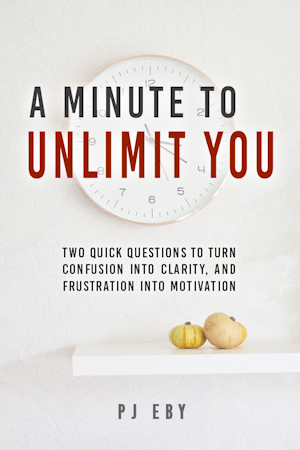Boy, do I feel stupid. All this time, I’ve been reading books about planning and organizing and just completely not getting it.
See, every single book says that to make a good plan, you need to break things down into smaller pieces. But my trouble is, those pieces get really small, really quick, so it seems like less trouble just to start the damn thing already.
Of course, what happens next is that I spend a ridiculous amount of time on preliminaries and fixing tiny details of things that aren’t really very important… especially if there aren’t any other people involved in the project, or any looming deadlines to keep me on track.
Now, they say that this is an ADD trait, something called “hyperfocus”. It can be really handy in cases where you really do need to focus in on something and get it absolutely right, but it’s also a perfect way to throw your project… or your life!…
Completely out of balance!
And in the last few days, I’ve been studying my own hyperfocus tendencies, trying to understand how they work and what could be done to mitigate them. And along the way, I’ve discovered what seem to be a set of three general principles or processes that have to be in place for a person’s life to be “organized”, in terms of either space or time.
Well, “discovered” is maybe too strong of a word. Thing is, these proceses are already implicitly expressed in many books, including the “Inside-Out” books by Julie Morgenstern. (“Organizing From The Inside Out“, and “Time Management From The Inside Out”.) But, in order to use these three processes, you first have to be able to plan well.
And unfortunately, there is one absolutely critical piece that seems to get left out of all these books: namely how to think in a way that naturally leads to making good plans! (Especially if you are blessed with – and/or suffer from – hyperfocus tendencies.)
Even “ADD-Friendly Ways To Organize Your Life” misses this piece entirely. I almost threw that book across the room when I kept finding section after section that basically recommended people with ADD get their non-ADD friends and family – or professional organizers – to do their thinking for them. (Jeez! So what did we need the freakin’ book for, then?)
But, it was really good for one thing: insight into all the ways in which this single “ADD” trait leads to all sorts of quality-of-life issues, through poor planning and prioritization. So it got me thoroughly motivated to figure out precisely how my thinking worked differently from that of the “normals”…
And what I could do instead!
So here’s what I figured out, about how to plan things in a “non-ADD” way:
Think in successive approximations by breadth-first traversals of the desired end-state.
Brilliant, isn’t it? Well, I guess I need to explain it first, so you’ll know what I actually mean. Otherwise, it won’t be of any more use to you, than all those organizing and time management books were to me!
See, the problems I’ve had with planning are all about three things: the sequence of my thoughts, the content of those thoughts, and their level of detail. When I start brainstorming a goal like “clean the house”, I end up with a list that mixes very high-level and low-level items in the same list, like “take out the trash” and “clean the living room”. (Different levels of detail.)
Sometimes, I’ll break down a few of the bigger pieces, but mostly what happens is that I pick only one, and dive into that one in great detail, until I get overwhelmed and don’t want to do any of it. Or, I don’t go into any further detail, and end up just doing the smaller, well-defined items…
Leaving the big pieces to rot indefinitely!
But, on the rare occasions that I’ve done well with planning a major project, it’s been when I’ve used processes that encourage the planning to occur in what programmers would call a “breadth-first” ordering.
In other words, instead of listing small pieces and big pieces together, it works much better if I first put all of the big pieces in one list, then make a pass back through the list to make more detailed sub-lists for each piece. Then, when all of those sub-lists are made, only then do I make any sub-sub-lists.
And the key insight that I got about this today, is that it allows you considerably greater flexibility in the planning process, as well as preventing hyperfocus from occurring at the wrong times, because it ensures that the links in your mind run in the right directions.
See, if I drill down too quickly, I lose sight of the big picture. I get caught up in solving the details of this one little thing, that might not be all that important overall. That’s because the sequence of my thoughts is going from a big chunk to successively smaller chunks of the same thing, instead of cutting back and forth over the big picture, seeing each part in relation to the whole.
Because, if I start immediately digging into “clean the living room”, it’s very easy to end up thinking about stuff like vacuuming or cleaning the carpet or re-organizing the bookshelves. But if my goal is just to have the house neat enough to have the copier repairman over to do some maintenance, then some of those actions might be…
Serious overkill!
And that brings up the last issue: content. By thinking this way, it’s all too easy to end up making a list of tasks, instead of a list of goals. Cleaning the living room is not really a goal; it’s merely a logical subdivision of a task… and a highly abstract one, at that! (I mean, what does it really mean to “clean the living room”, anyway? No wonder I’d get bogged down in it!)
And so, this way of thinking is really not planning. (Although I used to think it was!)
What we really need is not division at all, and certainly not of tasks! We want to see pieces of the desired end state, not the tasks required to get to that state. And, we need those pieces to be seen as a part of the overall goal. So, if my goal is to have the place clean enough for the copier repair guy to come over, then I need to progressively increase the level of detail I see in my envisioned result, while focusing on individual parts.
This would then result in me listing items that describe chunks of my vision. Like:
- “the floors and carpets between the front door and the copier room are free of non-furniture items”,
- “the tables and countertops visible on this side of the house are free of clutter and disarray”, and
- “the floors and carpets on this side of the house are free of any readily visible dirt or large stains”.
Then, when that list is finished, I can then break each subgoal into sub-subgoals like, “I’ve broken down all the Amazon shipping boxes and put the cardboard out for recycling.” And once these goals get small enough, they can be treated as if they were tasks instead… nice, well-defined, easy-to-do tasks. And, if I want to…
I can even do them in hyperfocus!
So, once again, the three keys of planning are to:
- Think in successive approximations,
- By breadth-first traversal,
- Of the desired end-state!
Successive approximation means you see things vaguely at first, then get more detailed. Breadth-first means you see the whole thing at a given level of detail before you go to a finer level of detail, thus keeping all the parts connected to the “big picture”. And finally, end-state means that the picture you’re making is of what you want, not what you have to do to get it.
Because if you leave out even one of these three things, you will get frustrated with both the planning and the execution of your goals. For example, I’ve been planning to write another book for well over a year now, but I’ve been repeatedly focusing on the wrong things.
So, when I’ve tried to plan, it’s always been ridiculous step-wise lists like “Step 1: write the outline… Step 2: write the book!”
Of course, I’ve never gotten past step 1, because I have the same problem with the outlining. My first book got finished only because I assembled it from already-written essays: if I’d tried to write it the way I’ve been trying to write my books since then…
I’d still be working on the outline!
See, when I’ve been trying to outline my book ideas, I’ve generally ended up drilling straight down into chapter 1 and then writing a chapter that really doesn’t go anywhere, leaving me with no idea what to do for a chapter 2. That’s because I’ve been trying to envision chapters as complete units, without first envisioning the whole book as a complete unit.
But now, I can easily see that what I need to do is to define successive approximations for the end state of my book. Not by asking what chapters it will have, but rather, what will someone know after reading it? How will they feel?
And most importantly, what will they do, and how will their lives be different as a result? Because that is what will determine what has to go into the book, and in what order.
So once I’ve answered these questions at a more general level, I can progressively break down the answers into smaller and smaller pieces. But, this will not be the outline of the book! See, that’s the problem I’ve been having up until now: trying to leap directly from this high-level definition down into a chapter-level outline.
What I need to do instead, is to break down the objectives into finer and finer pieces, then reassemble those pieces to build the outline back up again, from the bottom. That way, I’ll be able to sort out the best presentation order for the material as I arrange it, without getting into any blind spots of, “Oops, I probably should have covered this other bit first”, or…
“What the heck am I going to say next?!”
What’s crazy about all this, by the way, is that I’ve been digging through writing books for like the last two or three weeks, looking for stuff about how to outline a book, and nobody said a damn thing about this – or at least not anything that let me see how the way I’ve been doing it was wrong!
Anyway, now that I’ve seen how my old approach was broken and how this approach can actually work, I can already see how I can apply it. Not just to planning my books, but also to planning my time… organizing my workspace and bookshelves… heck, it even gives me some fresh ideas for improving my health!
Of course, I don’t know all the details yet (since that will come with successive approximations!), but I do know I’ll have a lot more to say about all this in the next Owners’ Circle newsletter, and probably on the CD as well.
I was actually inspired to investigate all this by an article I read recently about how small steps can make huge differences in performance. And it got me to wondering, what small steps could I change in my everyday life, that would have a similarly huge impact?
And I looked at a lot of different things, but they all ended up converging on this one point: lack of adequate planning and prioritization. So, I think this “one small step” is going to be one giant leap for me, not to mention for anyone else who has a similar problem!
Of course, you’ll actually have to practice this and put it to use, which is why I’ll be putting more detail and examples in the newsletter and CD.
Also, I should probably mention that the three keys I gave above for planning are not the same as the three processes I mentioned back at the beginning! The three processes are actually about how you get organized and manifest the results in your life, not how you create the plan or vision of what you want those results to be. There’s a big difference between the two… and you need both to be successful!
So, in addition to expanding some more on this planning process, the newsletter and CD will have even more to say about the “getting results” part.
Best wishes, and happy planning!




Sounds fine, although I like being disorganized. When one is organized, then one tends to know where one is going, and pretty soon one will end up with a speed track to one’s goal state, with fewer and fewer options. The problem is that following this speed track causes what you describe: success, hyperfocus, etc, which while potentially granting social or personal rewards in a postindustrial society of specialized skills, actually decreases long-term happiness because of the increasing inhumanity of repetitive, goal-directed behavior. For me at least, maximizing options while having no goals makes the journey more interesting. The success stuff is worthless anyway. Lots of people have lots of goals only to end up dying alone having lived uninteresting lives as WASP robots. Goals are potentially a threat, because they encourage WARP robot syndrome.
I’m likely ADHD, so I know what you mean about the hyperfocus and wandering in random directions. It’s totally, like, cool though.
Sounds like sour grapes to me. Just of a hyperfocused, highly-intellectual variety. 😉
I spent most of my life “maximizing options” instead of actually succeeding at anything. But then, sometimes there are things you WANT to succeed at, and then where are you?
In contrast, if you are able to produce a result you envision, then you can choose whether or not to pursue something… instead of being forced to “maximize your options” instead.
So which one *really* gives you more freedom? The one where you can, but have the option of choosing not to?
Or the one where you have no choice, because you can’t?
Great article – you rock.
It’s a great breakdown of how to get past extreme disorganization (I resemble that remark).
I’ll be taking some notes to cement this into my brain, because I hate being disorganized. It wreaks havoc in my personal and business life and wastes incredible amounts of time.
Thanks.
I am particularly interested in what you are saying about writing a book. I’ve been gathering material and ideas and planning it all out since 2004 and still have nothing actually written. Why? Because I’m “getting everything ready and perfect”. I have to get the chapter outlines right or I’ll be wasting my time writing stuff that won’t fit together. At least, that’s what I’m telling myself. Looking to the “end state” of the book and how to do that is just so helpful for me. It makes so much sense and fits very well with what I believe and want my book to be. I actually can’t understand why I didn’t think of it myself!! I can’t wait to get back to my book because I now feel that I have some real direction in making it reality. So thanks.
http://www.wikihow.com/Plan-a-Project-Using-the-Getting-Things-Done-Method
Does the above fit what you are talking about PJ?
Robert
It's not the same thing, if that's what you're asking. This is more like *how* to map out the parts that the GTD process describes in a "just do it" sort of way.